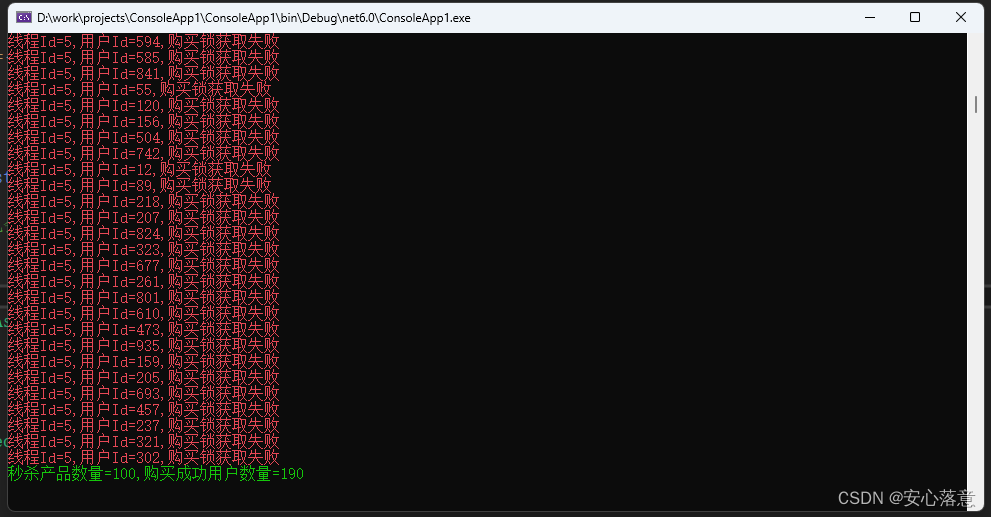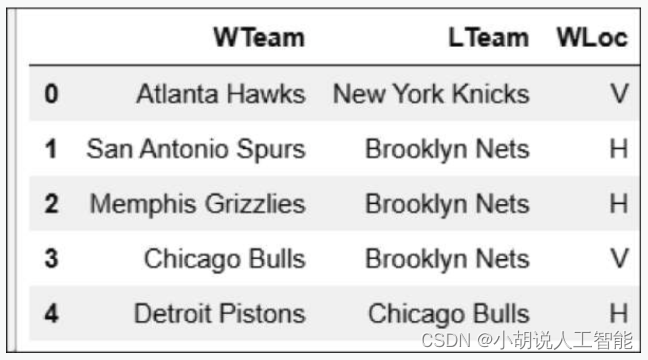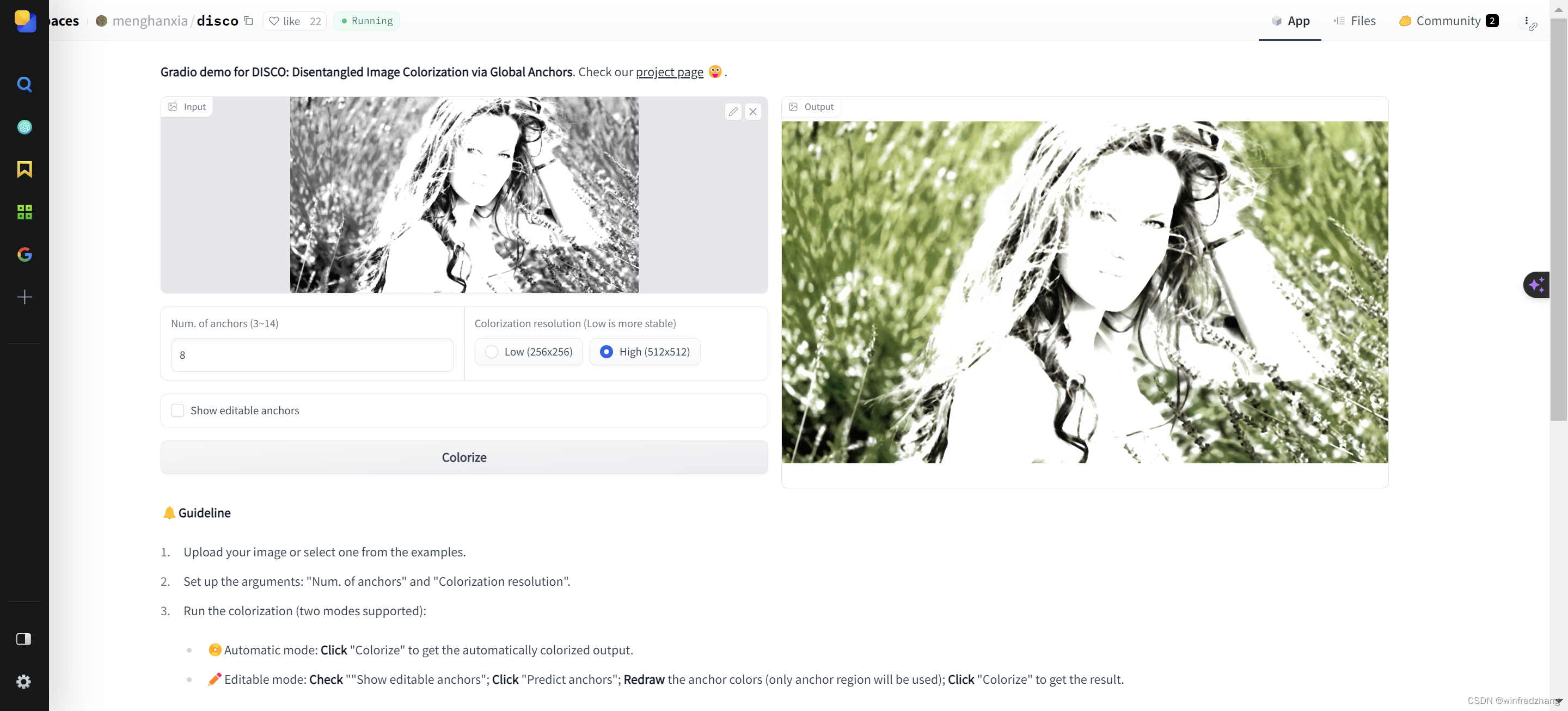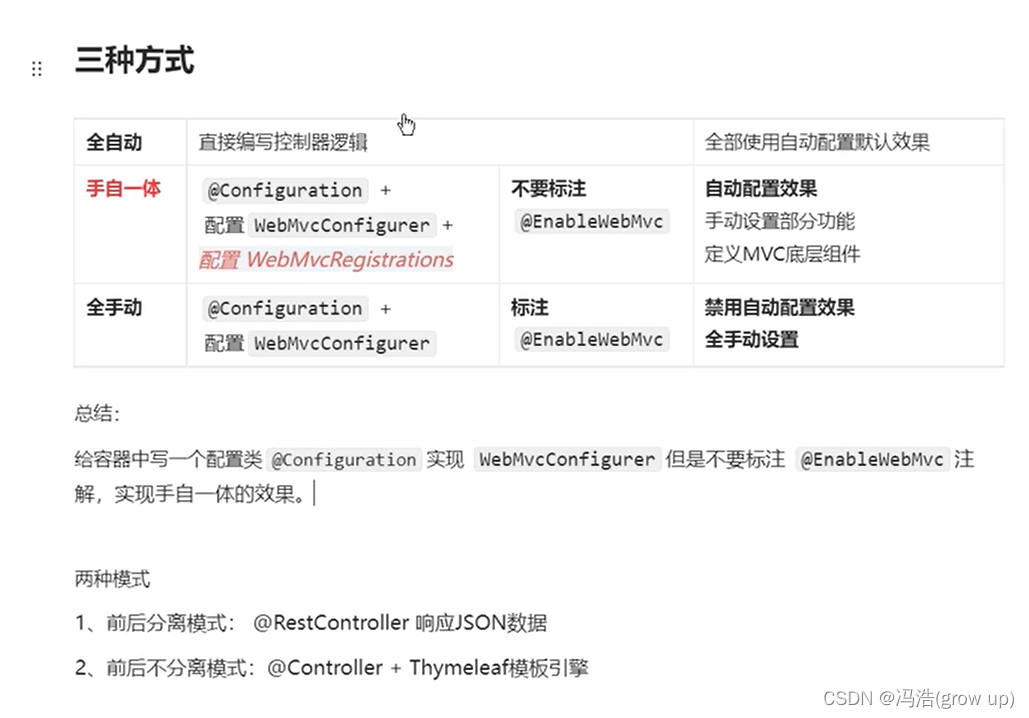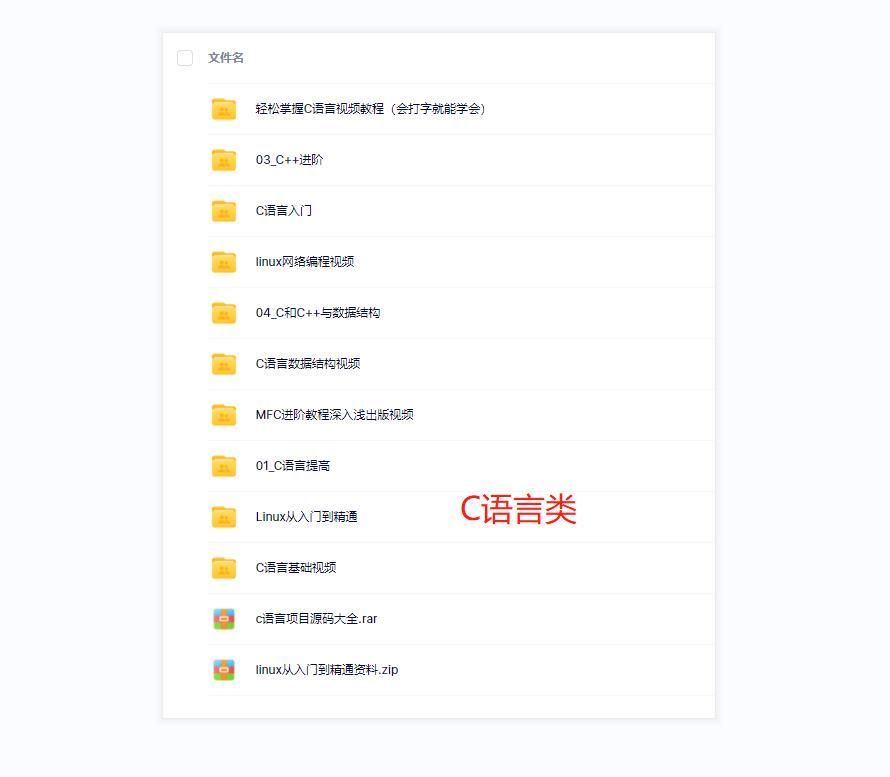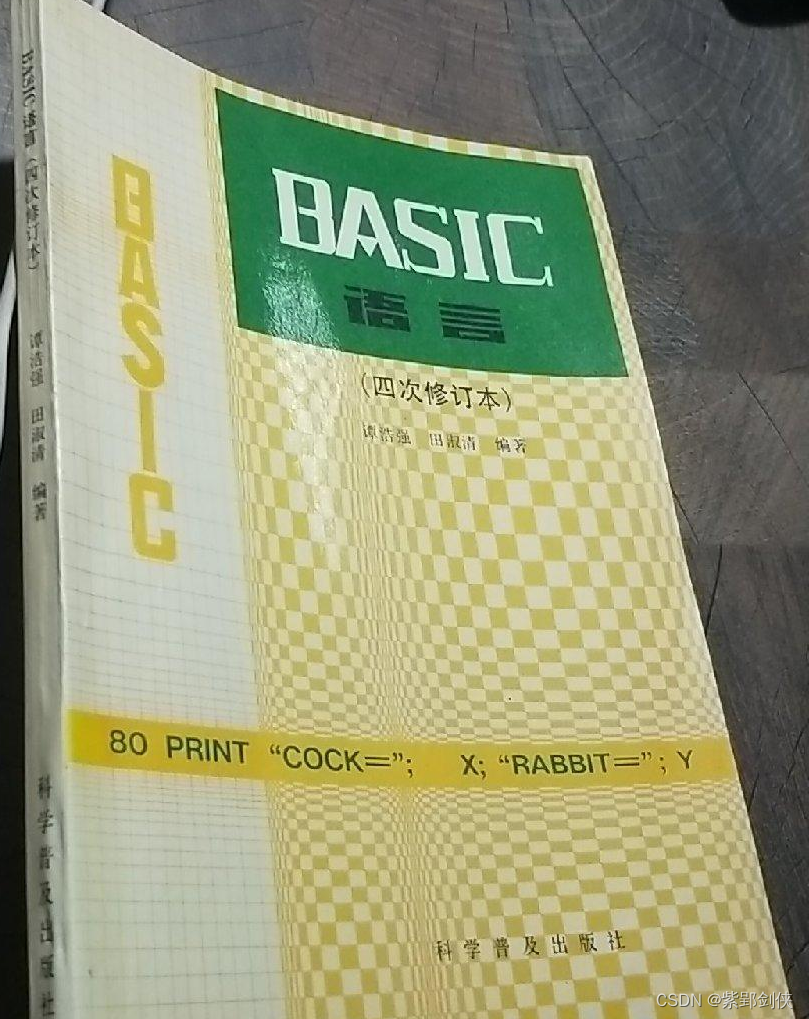Spring简介
Spring是一个开源框架,为简化企业级开发而生。它以IOC(控制反转)和AOP(面向切面)为思想内核,提供了控制层
SpringMVC、数据层SpringData、服务层事务管理等众多技术,并可以整合众多第三方框架。
Spring将很多复杂的代码变得优雅简洁,有效的降低代码的耦合度,极大的方便项目的后期维护、升级和扩展。
Spring官网地址:https://spring.io/
Spring体系结构
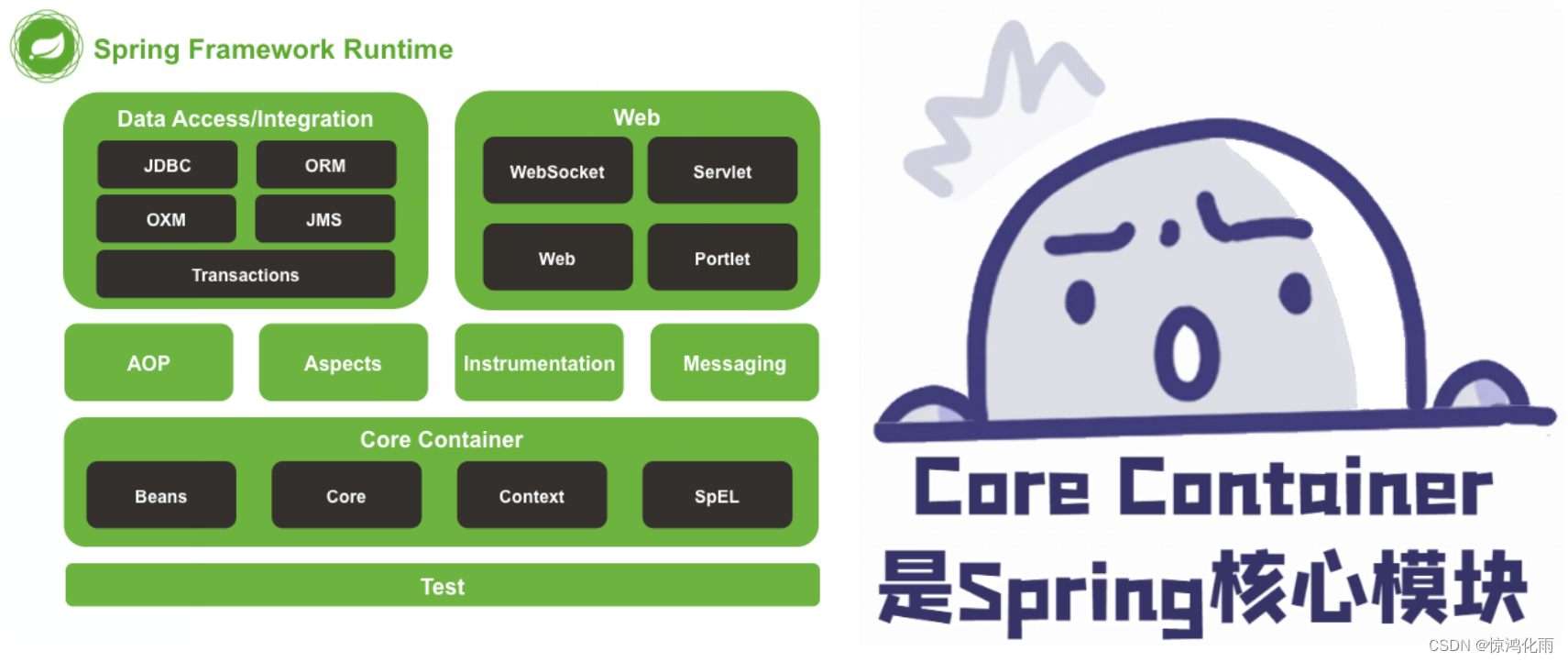
Spring框架根据不同的功能被划分成了多个模块,这些模块可以满足一切企业级应用开发的需求,在开发过程中可以根据需求有选择性地使用所需要的模块。
- Core Container:Spring核心模块,任何功能的使用都离不开该模块,是其他模块建立的基础。
- Data Access/Integration:该模块提供了数据持久化的相应功能。
- Web:该模块提供了web开发的相应功能。
- AOP:提供了面向切面编程实现
- Aspects:提供与AspectJ框架的集成,该框架是一个面向切面编程框架。
- Instrumentation:提供了类工具的支持和类加载器的实现,可以在特定的应用服务器中使用。
- Messaging:为Spring框架集成一些基础的报文传送应用
- Test:提供与测试框架的集成
IOC_控制反转思想
IOC(Inversion of Control) :程序将创建对象的权利交给框架。
之前在开发过程中,对象实例的创建是由调用者管理的
这种写法有两个缺点:
- 浪费资源:StudentService调用方法时即会创建一个对象,如果不断调用方法则会创建大量StudentDao对象。
- 代码耦合度高:假设随着开发,我们创建了StudentDao另一个更加完善的实现类StudentDaoImpl2,如果在StudentService中想使用StudentDaoImpl2,则必须修改源码。
而IOC思想是将创建对象的权利交给框架,框架会帮助我们创建对象,分配对象的使用,控制权由程序代码转移到了框架中,控制权
发生了反转,这就是Spring的IOC思想。而IOC思想可以完美的解决以上两个问题。
IOC_Spring实现IOC
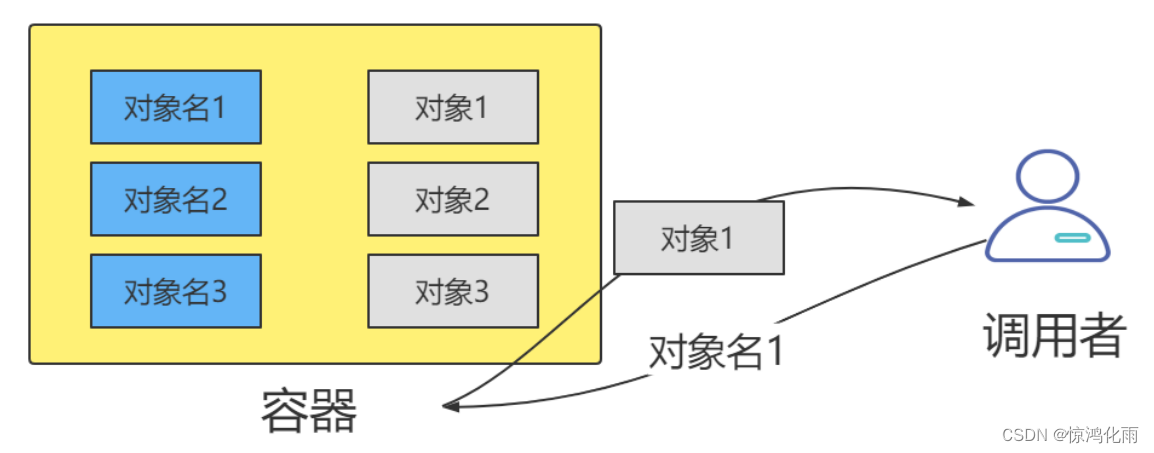
- 创建Maven工程,引入依赖
<dependencies>
<dependency>
<groupId>org.springframework</groupId>
<artifactId>spring-context</artifactId>
<version>5.3.13</version>
</dependency>
<dependency>
<groupId>junit</groupId>
<artifactId>junit</artifactId>
<version>4.12</version>
<scope>test</scope>
</dependency>
</dependencies>
- 创建POJO类、Dao类和接口
public class Student {
private int id;
private String name;
private String address;
// 省略getter/setter/构造方法/tostring
}
public interface StudentDao {
// 根据id查询学生
Student findById(int id);
}
public class StudentDaoImpl implements StudentDao{
@Override
public Student findById(int id) {
// 模拟从数据库查找出学生
return new Student(1,"程序员","北京");
}
}
- 编写xml配置文件,配置文件中配置需要Spring帮我们创建的对象
<?xml version="1.0" encoding="UTF-8"?>
<beans xmlns="http://www.springframework.org/schema/beans"
xmlns:xsi="http://www.w3.org/2001/XMLSchema-instance"
xsi:schemaLocation="http://www.springframework.org/schema/beans
http://www.springframework.org/schema/beans/spring-beans.xsd">
<bean id="studentDao" class="com.gb.dao.StudentDaoImpl"></bean>
</beans>
- 测试从Spring容器中获取对象。
public class TestContainer {
@Test
public void t1(){
// 创建Spring容器
ApplicationContext ac = new ClassPathXmlApplicationContext("bean.xml");
// 从容器获取对象
StudentDao studentDao1 = (StudentDao) ac.getBean("studentDao");
StudentDao studentDao2 = (StudentDao) ac.getBean("studentDao");
System.out.println(studentDao1.hashCode());
System.out.println(studentDao2.hashCode());
System.out.println(studentDao1.findById(1));
}
}
IOC_Spring容器类型
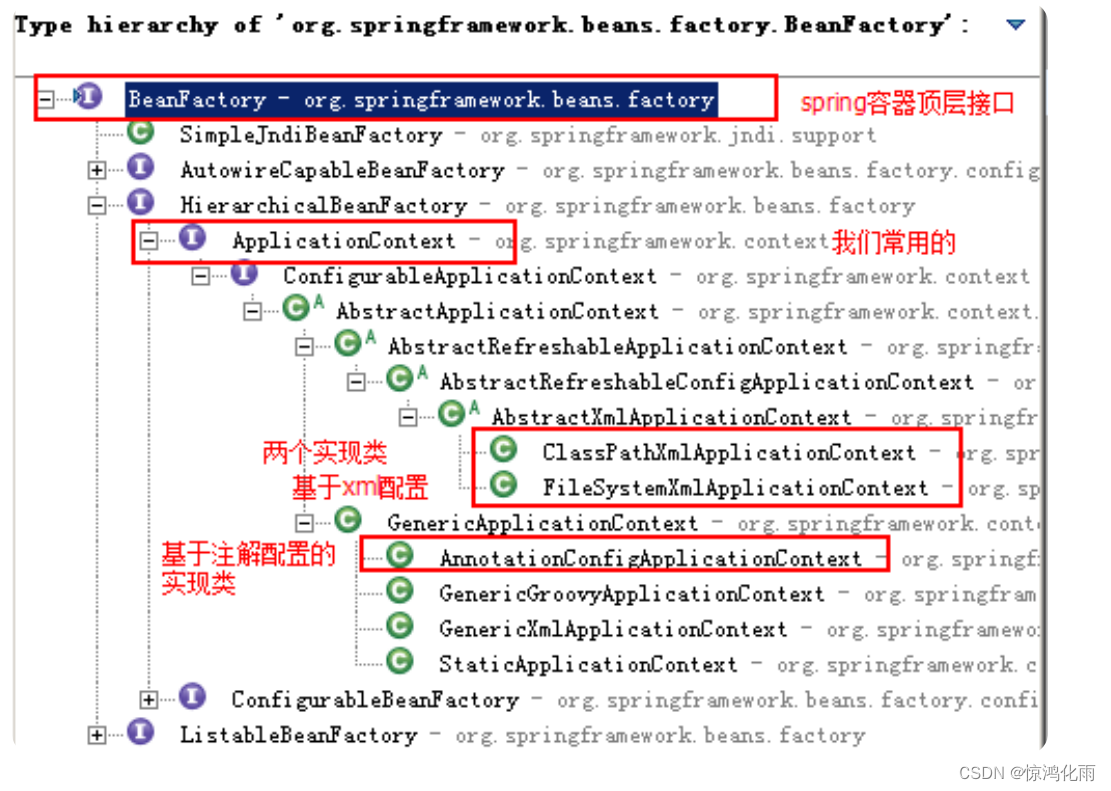
容器接口
- BeanFactory:BeanFactory是Spring容器中的顶层接口,它可以对Bean对象进行管理。
- ApplicationContext:ApplicationContext是BeanFactory的子接口。它除了继承 BeanFactory的所有功能外,还添加了对国际化、资源访问、事件传播等方面的良好支持。
ApplicationContext有以下三个常用实现类:
- ClassPathXmlApplicationContext:该类可以从项目中读取配置文件
- FileSystemXmlApplicationContext:该类从磁盘中读取配置文件
- AnnotationConfigApplicationContext:使用该类不读取配置文件,而是会读取注解
@Test
public void t2(){
// 创建spring容器
// ApplicationContext ac = new ClassPathXmlApplicationContext("bean.xml");
ApplicationContext ac = new FileSystemXmlApplicationContext("C:\\Users\\a\\IdeaProjects\\spring_demo\\src\\main\\resources\\bean.xml");
// 从容器中获取对象
StudentDao userDao = (StudentDao)ac.getBean("studentDao");
System.out.println(userDao);
System.out.println(userDao.findById(1));
}
IOC_对象的创建方式
使用构造方法
Spring默认使用类的空参构造方法创建bean:
使用工厂类的方法
Spring可以调用工厂类的方法创建bean:
- 创建工厂类,工厂类提供创建对象的方法:
public class StudentDaoFactory {
public StudentDao getStudentDao(){
return new StudentDaoImpl(1);
}
}
- 在配置文件中配置创建bean的方式为工厂方式。
<bean id="studentDaoFactory" class="com.gb.dao.StudentDaoFactory"></bean>
<!-- id:bean对象的id,factory-bean:工厂对象的id,factory-method:工厂方法 -->
<bean id="studentDao" factory-bean="studentDaoFactory" factory-method="getStudentDao"></bean>
使用工厂类的静态方法
Spring可以调用工厂类的静态方法创建bean:
<!-- id:bean的id class:工厂全类名 factory-method:工厂静态方法 -->
<bean id="studentDao" class="com.gb.dao.StudentDaoFactory2" factory-method="getStudentDao"></bean>
IOC_对象的创建策略
Spring通过配置 <bean> 中的 scope 属性设置对象的创建策略,共有五种创建策略:
- singleton:单例,默认策略。整个项目只会创建一个对象,通过
<bean>中的 lazy-init 属性可以设置单例对象的创建时机:
lazy-init=“false”(默认):立即创建,在容器启动时会创建配置文件中的所有Bean对象。
lazy-init=“true”:延迟创建,第一次使用Bean对象时才会创建。
- prototype:多例,每次从容器中获取时都会创建对象。
- request:每次请求创建一个对象,只在web环境有效。
- session:每次会话创建一个对象,只在web环境有效。
- gloabal-session:一次集群环境的会话创建一个对象,只在web环境有效。
IOC_对象的销毁时机
对象的创建策略不同,销毁时机也不同:
- singleton:对象随着容器的销毁而销毁。
- prototype:使用JAVA垃圾回收机制销毁对象。
- request:当处理请求结束,bean实例将被销毁。
- session:当HTTP Session最终被废弃的时候,bean也会被销毁掉。
- gloabal-session:集群环境下的session销毁,bean实例也将被销毁。
IOC_生命周期方法
Bean对象的生命周期包含创建——使用——销毁,Spring可以配置Bean对象在创建和销毁时自动执行的方法:
- 定义生命周期方法
public class StudentDaoImpl2 implements
StudentDao{
// 创建时自动执行的方法
public void init(){
System.out.println("创建StudentDao!!!");
}
// 销毁时自动执行的方法
public void destory(){
System.out.println("销毁StudentDao!!!");
}
}
- 配置生命周期方法
<!-- init-method:创建对象时执行的方法
destroy-method:销毁对象时执行的方法 -->
<bean id="studentDao" class="com.gb.dao.StudentDaoImpl2" scope="singleton" init-method="init" destroy-method="destory"></bean>
- 测试
@Test
public void t3(){
// 创建Spring容器
ClassPathXmlApplicationContext ac =new ClassPathXmlApplicationContext("bean1.xml");
// 销毁Spring容器,ClassPathXmlApplicationContext才有销毁容器的方法
ac.close();
}
IOC_获取Bean对象的方式
通过id/name获取
- 配置文件
<bean name="studentDao" class="com.gb.dao.StudentDaoImpl2"></bean>
<bean id="studentDao" class="com.gb.dao.StudentDaoImpl2"></bean>
- 获取对象
StudentDao studentDao = (StudentDao)ac.getBean("studentDao");
通过类型获取
- 配置文件
<bean name="studentDao" class="com.gb.dao.StudentDaoImpl2"></bean>
- 获取对象
StudentDao studentDao = (StudentDao)ac.getBean("StudentDao.class");
可以看到使用类型获取不需要强转。
通过类型+id/name获取
虽然使用类型获取不需要强转,但如果在容器中有一个接口的多个实现类对象,则获取时会报错,此时需要使用类型+id/name获取
- 配置文件
<bean name="studentDao" class="com.gb.dao.StudentDaoImpl2"></bean>
<bean name="studentDao1" class="com.gb.dao.StudentDaoImpl"></bean>
- 获取对象
StudentDao studentDao2 = ac.getBean("studentDao",StudentDao.class);
DI_什么是依赖注入
依赖注入(Dependency Injection,简称DI),它是Spring控制反转思想的具体实现。
控制反转将对象的创建交给了Spring,但是对象中可能会依赖其他对象。比如service类中要有dao类的属性,我们称service依赖于dao。
简单来说,控制反转是创建对象,依赖注入是为对象的属性赋值。
DI_依赖注入方式
Setter注入
1 被注入类编写属性的setter方法
public class StudentService {
private StudentDao studentDao;
public void setStudentDao(StudentDao studentDao) {
this.studentDao = studentDao;
}
}
- 配置文件中,给需要注入属性值的
<bean>中设置<property>
<bean id="studentDao" class="com.gb.dao.StudentDaoImpl"></bean>
<bean id="studentService" class="com.gb.service.StudentService">
<!--依赖注入-->
<!--name:对象的属性名 ref:容器中对象的id值-->
<property name="studentDao" ref="studentDao"></property>
</bean>
构造方法注入
- 被注入类编写有参的构造方法
public class StudentService {
private StudentDao studentDao;
public StudentService(StudentDao studentDao) {
this.studentDao = studentDao;
}
}
- 给需要注入属性值的
<bean>中设置<constructor-arg>
<bean id="studentDao" class="com.gb.dao.StudentDaoImpl"></bean>
<bean id="studentService" class="com.gb.service.StudentService">
<!-- 依赖注入 -->
<!-- name:对象的属性名 ref:配置文件中注入对象的id值 -->
<constructor-arg name="studentDao" ref="studentDao"></constructor-arg>
</bean>
自动注入
自动注入不需要在 <bean> 标签中添加其他标签注入属性值,而是自动从容器中找到相应的bean对象设置为属性值。
自动注入有两种配置方式:
- 全局配置:在
<beans>中设置 default-autowire 属性可以定义所有bean对象的自动注入策略。- 局部配置:在
<bean>中设置 autowire 属性可以定义当前bean对象的自动注入策略。
autowire的取值如下:
- no:不会进行自动注入。
- default:全局配置default相当于no,局部配置default表示使用全局配置
- byName:在Spring容器中查找id与属性名相同的bean,并进行注入。需要提供set方法。
- byType:在Spring容器中查找类型与属性类型相同的bean,并进行注入。需要提供set方法。
- constructor:在Spring容器中查找id与属性名相同的bean,并进行注入。需要提供构造方法。
测试自动注入:
- 为依赖的对象提供setter和构造方法:
public class StudentService {
// 依赖
private StudentDao studentDao;
// 构造方法
public StudentService() {}
public StudentService(StudentDao studentDao) {
this.studentDao = studentDao;
}
// setter方法
public void setStudentDao(StudentDao studentDao) {
this.studentDao = studentDao;
}
// 调用依赖的方法
public Student findStudentById(int id){
return studentDao.findById(id);
}
}
- 配置自动注入:
<!-- 根据beanId等于属性名自动注入 -->
<bean id="studentDao" class="com.gb.dao.StudentDaoImpl"></bean>
<bean id="studentService"class="com.gb.service.StudentService" autowire="byName"></bean>
<!-- 根据bean类型等于属性类型自动注入 -->
<bean id="studentDao" class="com.gb.dao.StudentDaoImpl"></bean>
<bean id="studentService" class="com.gb.service.StudentService" autowire="byType"></bean>
<!-- 利用构造方法自动注入 -->
<bean id="studentDao" class="com.gb.dao.StudentDaoImpl"></bean>
<bean id="studentService" class="com.gb.service.StudentService" autowire="constructor"></bean>
<!-- 配置全局自动注入 -->
<beans xmlns="http://www.springframework.org/schema/beans"
xmlns:xsi="http://www.w3.org/2001/XMLSchema-instance"
xsi:schemaLocation="http://www.springframework.org/schema/beans
http://www.springframework.org/schema/beans/spring-beans.xsd"
default-autowire="constructor">
DI_依赖注入类型

DI支持注入bean类型、基本数据类型和字符串、List集合、Set集合、Map集合、Properties对象类型等,他们的写法如下:
- 准备注入属性的类
public class StudentService {
private StudentDao studentDao; // bean属性
private String name; //字符串类型
private int count; //基本数据类型
private List<String> names; // 字符串类型List集合
private List<Student> students1; // 对象类型List集合
private Set<Student> students2; // 对象类型Set集合
private Map<String,String> names2; //字符串类型Map集合
private Map<String,Student> students3;
// 对象类型Map集合
private Properties properties;
//Properties类型
// 省略getter/setter/toString
}
注入bean类型
写法一:
<bean id="studentDao" class="com.gb.dao.StudentDaoImpl"></bean>
<bean id="studentService" class="com.gb.service.StudentService">
<property name="studentDao" ref="studentDao"></property>
</bean>
写法二:
<bean id="studentDao" class="com.itbaizhan.dao.StudentDaoImpl"></bean>
<bean id="studentService" class="com.itbaizhan.service.StudentService">
<property name="studentDao" >
<ref bean="studentDao"></ref>
</property>
</bean>
注入基本数据类型
<bean id="studentService"
class="com.itbaizhan.service.StudentService">
<!-- 写法一 name:属性名 value:属性值-->
<property name="name" value="程序员"></property>
<!-- 写法二 name:属性名 value:属性值-->
<property name="count">
<value>10</value>
</property>
</bean>
注入List集合
<bean id="studentService" class="com.gb.service.StudentService">
<!-- 简单数据类型List集合 name:属性名 -->
<property name="names">
<list>
<value>程序员</value>
<value>悍匪</value>
</list>
</property>
<!-- 对象类型List集合 name:属性名 -->
<property name="students1">
<list>
<bean class="com.gb.domain.Student">
<property name="id" value="1"/>
<property name="name" value="Java"/>
<property name="address" value="北京"/>
</bean>
<bean class="com.gb.domain.Student">
<property name="id" value="2"/>
<property name="name" value="大数据"/>
<property name="address" value="北京"/>
</bean>
</list>
</property>
</bean>
注入Set集合
<bean id="studentService" class="com.itbaizhan.service.StudentService">
<!-- Set集合 -->
<property name="students2">
<set>
<bean class="com.itbaizhan.domain.Student">
<property name="id" value="1"/>
<property name="name" value="悍匪"/>
<property name="address" value="北京"/>
</bean>
<bean class="com.itbaizhan.domain.Student">
<property name="id" value="2"/>
<property name="name" value="程序员"/>
<property name="address"value="北京"/>
</bean>
</set>
</property>
</bean>
注入Map集合
简单数据类型Map集合:
<bean id="studentService" class="com.gb.service.StudentService">
<property name="names2">
<map>
<entry key="student1" value="bz"/>
<entry key="student2" value="sxt"/>
</map>
</property>
</bean>
对象类型Map集合:
<bean id="studentService" class="com.gb.service.StudentService">
<property name="students3">
<map>
<entry key="student1" value-ref="s1"/>
<entry key="student2" valueref="s2"/>
</map>
</property>
</bean>
<bean id="s1"class="com.gb.domain.Student">
<property name="id" value="1"/>
<property name="name" value="尚学堂"/>
<property name="address" value="北京"/>
</bean>
<bean id="s2" class="com.gb.domain.Student">
<property name="id" value="2"/>
<property name="name" value="百战"/>
<property name="address" value="北京"/>
</bean>
注入Properties对象
<bean id="studentService" class="com.gb.service.StudentService">
<property name="properties">
<props>
<prop key="配置1">值1</prop>
<prop key="配置2">值2</prop>
</props>
</property>
</bean>
注解实现IOC
准备工作
- 创建一个新的Spring项目。
- 编写pojo,dao,service类。
- 编写空的配置文件,如果想让该文件支持注解,需要添加新的约束:
<?xml version="1.0" encoding="UTF-8"?>
<beans xmlns="http://www.springframework.org/schema/beans"
xmlns:context="http://www.springframework.org/schema/context"
xmlns:xsi="http://www.w3.org/2001/XMLSchema-instance"
xsi:schemaLocation="http://www.springframework.org/schema/beans
http://www.springframework.org/schema/beans/spring-beans.xsd
http://www.springframework.org/schema/context
http://www.springframework.org/schema/context/spring-context.xsd">
</beans>
@Component注解
作用:用于创建对象,放入Spring容器,相当于 <bean id="" class="">
位置:类上方
注意:
- 要在配置文件中配置扫描的包,扫描到该注解才能生效。
<!-- 扫描包 -->
<context:component-scan base-package="com.gb"></context:component-scan>
@Component 注解配置bean的默认id是首字母小写的类名。也可以手动设置bean的id值。
// 此时bean的id为studentDaoImpl
@Component
public class StudentDaoImpl implements StudentDao{
public Student findById(int id) {
// 模拟根据id查询学生
return new Student(1,"程序员","北京");
}
}
// 此时bean的id为studentDao
@Component("studentDao")
public class StudentDaoImpl implements StudentDao{
public Student findById(int id) {
// 模拟根据id查询学生
return new Student(1,"程序员","北京");
}
}
@Repository、@Service、@Controller
作用:这三个注解和@Component的作用一样,使用它们是为了区分该类属于什么层。
位置:
- @Repository用于Dao层
- @Service用于Service层
- @Controller用于Controller层
@Scope
作用:指定bean的创建策略
位置:类上方
取值:singleton prototype request session globalsession
@Service
@Scope("singleton")
public class StudentService {}
@Autowired
作用:从容器中查找符合属性类型的对象自动注入属性中。用于代替 <bean> 中的依赖注入配置。
位置:属性上方、setter方法上方、构造方法上方。
注意:
- @Autowired 写在属性上方进行依赖注入时,可以省略setter方法。
- 容器中没有对应类型的对象会报错
- 容器中有多个对象匹配类型时,会找beanId等于属性名的对象,找不到会报错。
@Qualifier
作用:在按照类型注入对象的基础上,再按照bean的id注入。
位置:属性上方
注意:@Qualifier必须和@Autowired一起使用。
@Value
作用:注入String类型和基本数据类型的属性值。
位置:属性上方
@Configuration
纯注解实现IOC需要一个Java类代替xml文件。这个Java类上方需要添加@Configuration,表示该类是一个配置类,作用是代替配置文件。
@Configuration
public class SpringConfig {
}
@ComponentScan
作用:指定spring在初始化容器时扫描的包。
位置:配置类上方
@Configuration
@ComponentScan("com.gb")
public class SpringConfig {
}
@PropertySource
作用:代替配置文件中的 <context:property-placeholder> 扫描配置文件
位置:配置类上方
注意:配置文件位置前要加关键字 classpath
@Configuration
@PropertySource("classpath:db.properties")
public class JdbcConfig {
@Value("${jdbc.username}")
private String username;
@Value("${jdbc.password}")
private String password;
}
@Bean
作用:将方法的返回值对象放入Spring容器中。如果想将第三方类的对象放入容器,可以使用@Bean
位置:配置类的方法上方。
属性:name:给bean对象设置id
注意:@Bean修饰的方法如果有参数,spring会根据参数类型从容器中查找可用对象。
@Import
作用:如果配置过多,会有多个配置类,该注解可以为主配置类导入其他配置类
位置:主配置类上方
SpringAOP_AOP简介
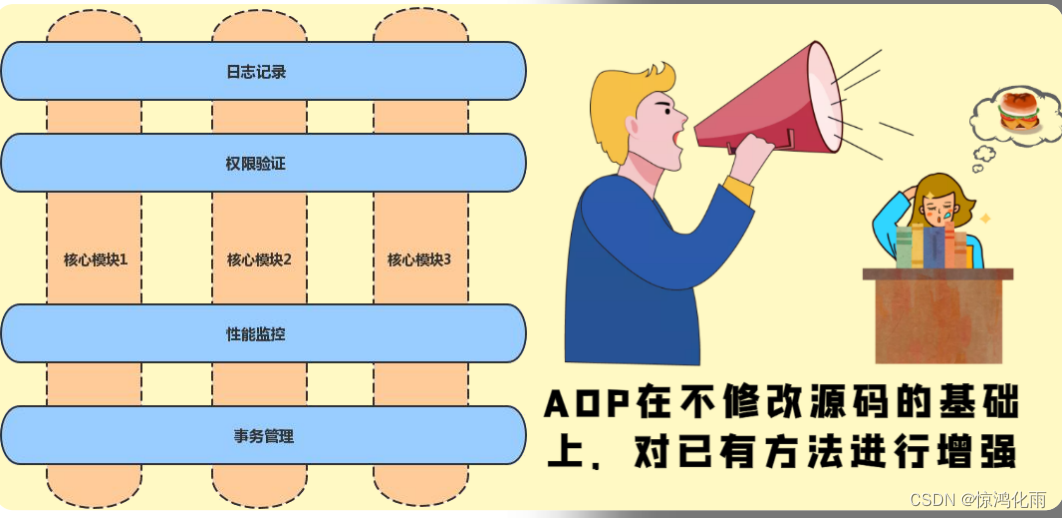
AOP的全称是Aspect Oriented Programming,即面向切面编程。是实现功能统一维护的一种技术,它将业务逻辑的各个部分进行隔
离,使开发人员在编写业务逻辑时可以专心于核心业务,从而提高了开发效率。
- 作用:在不修改源码的基础上,对已有方法进行增强。
- 实现原理:动态代理技术。
- 优势:减少重复代码、提高开发效率、维护方便
- 应用场景:事务处理、日志管理、权限控制、异常处理等方面。
SpringAOP_AOP相关术语
| 名称 | 说明 |
|---|---|
| Joinpoint | (连接点) 指能被拦截到的点,在Spring中只有方法能被拦截。 |
| Pointcut | (切点) 指要对哪些连接点进行拦截,即被增强的方法。 |
| Advice | (通知) 指拦截后要做的事情,即切点被拦截后执行的方法。 |
| Aspect | (切面) 切点+通知称为切面 |
| Target | (目标) 被代理的对象 |
| Proxy | (代理) 代理对象 |
| Weaving | (织入) 生成代理对象的过程 |
SpringAOP_AOP入门
AspectJ是一个基于Java语言的AOP框架,在Spring框架中建议使用AspectJ实现AOP。
接下来我们写一个AOP入门案例:dao层的每个方法结束后都可以打印一条日志:
- 引入依赖
<!-- spring -->
<dependency>
<groupId>org.springframework</groupId>
<artifactId>springcontext</artifactId>
<version>5.3.13</version>
</dependency>
<!-- AspectJ -->
<dependency>
<groupId>org.aspectj</groupId>
<artifactId>aspectjweaver</artifactId>
<version>1.8.7</version>
</dependency>
<!-- junit -->
<dependency>
<groupId>junit</groupId>
<artifactId>junit</artifactId>
<version>4.12</version>
<scope>test</scope>
</dependency>
- 编写连接点
@Repository
public class UserDao {
public void add(){
System.out.println("用户新增");
}
public void delete(){
System.out.println("用户删除");
}
public void update(){
System.out.println("用户修改");
}
}
- 编写通知类
public class MyAspectJAdvice {
// 后置通知
public void myAfterReturning() {
System.out.println("打印日志...");
}
}
- 配置切面
<?xml version="1.0" encoding="UTF-8"?>
<beans xmlns="http://www.springframework.org/schema/beans"
xmlns:context="http://www.springframework.org/schema/context"
xmlns:xsi="http://www.w3.org/2001/XMLSchema-instance" xmlns:tx="http://www.springframework.org/schema/tx"
xmlns:aop="http://www.springframework.org/schema/aop"
xsi:schemaLocation="http://www.springframework.org/schema/beans
http://www.springframework.org/schema/beans/spring-beans.xsd
http://www.springframework.org/schema/context
http://www.springframework.org/schema/context/spring-context.xsd http://www.springframework.org/schema/tx http://www.springframework.org/schema/tx/spring-tx.xsd http://www.springframework.org/schema/aop https://www.springframework.org/schema/aop/spring-aop.xsd">
<context:component-scan base-package="com.gb"></context:component-scan>
<!-- 通知对象 -->
<bean id="myAspectJAdvice" class="com.gb.advice.MyAspectAdvice"></bean>
<!-- 配置AOP -->
<aop:config>
<!-- 配置切面 -->
<aop:aspect ref="myAspectJAdvice">
<!-- 配置切点 -->
<aop:pointcut id="myPointcut" expression="execution(* com.gb.dao.UserDao.*(..))"/>
<!-- 配置通知 -->
<aop:after-returning method="myAfterReturning" pointcut-ref="myPointcut"/>
</aop:aspect>
</aop:config>
</beans>
SpringAOP_通知类型
AOP有以下几种常用的通知类型:
| 通知类型 | 描述 |
|---|---|
| 前置通知 | 在方法执行前添加功能 |
| 后置通知 | 在方法正常执行后添加功能 |
| 异常通知 | 在方法抛出异常后添加功能 |
| 最终通知 | 无论方法是否抛出异常,都会执行该通知 |
| 环绕通知 | 在方法执行前后添加功能 |
- 编写通知方法
// 通知类
public class MyAspectAdvice {
// 后置通知
public void myAfterReturning(JoinPoint joinPoint) {
System.out.println("切点方法名:" + joinPoint.getSignature().getName());
System.out.println("目标对象:" + joinPoint.getTarget());
System.out.println("打印日志" + joinPoint.getSignature().getName() + "方法被执行了!");
}
// 前置通知
public void myBefore() {
System.out.println("前置通知...");
}
// 异常通知
public void myAfterThrowing(Exception ex) {
System.out.println("异常通知...");
System.err.println(ex.getMessage());
}
// 最终通知
public void myAfter() {
System.out.println("最终通知");
}
// 环绕通知
public Object myAround(ProceedingJoinPoint proceedingJoinPoint) throws Throwable {
System.out.println("环绕前");
Object obj = proceedingJoinPoint.proceed(); // 执行方法
System.out.println("环绕后");
return obj;
}
}
- 配置切面
<!-- 配置AOP -->
<aop:config>
<!-- 配置切面 -->
<aop:aspect ref="myAspectJAdvice">
<!-- 配置切点 -->
<aop:pointcut id="myPointcut" expression="execution(* com.gb.dao.UserDao.*(..))"/>
<!-- 前置通知 -->
<aop:before method="myBefore" pointcut-ref="myPointcut"></aop:before>
<!-- 后置通知 -->
<aop:after-returning method="myAfterReturning" pointcutref="myPointcut"/>
<!-- 异常通知 -->
<aop:after-throwing method="myAfterThrowing" pointcutref="myPointcut" throwing="ex"/>
<!-- 最终通知 -->
<aop:after method="myAfter" pointcut-ref="myPointcut"></aop:after>
<!-- 环绕通知 -->
<aop:around method="myAround" pointcut-ref="myPointcut"></aop:around>
</aop:aspect>
</aop:config>
SpringAOP_切点表达式
使用AspectJ需要使用切点表达式配置切点位置,写法如下:
-
标准写法:访问修饰符 返回值 包名.类名.方法名(参数列表)
-
访问修饰符可以省略。
-
返回值使用 * 代表任意类型。
-
包名使用 * 表示任意包,多级包结构要写多个 * ,使用 *… 表示任意包结构
-
类名和方法名都可以用 * 实现通配。
-
参数列表
- 基本数据类型直接写类型
- 引用类型写 包名.类名
- * 表示匹配一个任意类型参数
- … 表示匹配任意类型任意个数的参数
-
全通配: * *…*.*(…)
SpringAOP_多切面配置
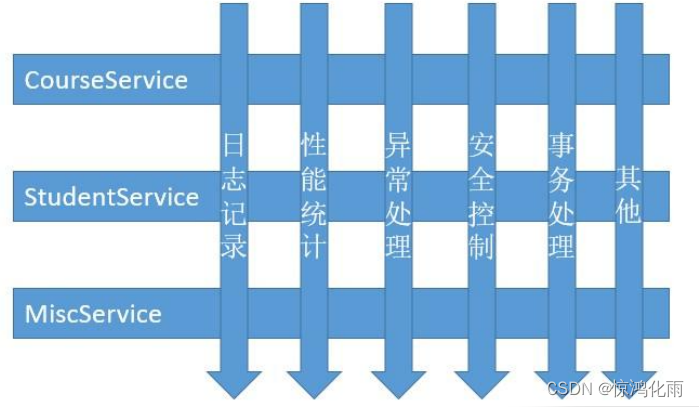
我们可以为切点配置多个通知,形成多切面,比如希望dao层的每个方法结束后都可以打印日志并发送邮件:
- 编写发送邮件的通知:
public class MyAspectJAdvice2 {
// 后置通知
public void myAfterReturning(JoinPoint joinPoint) {
System.out.println("发送邮件");
}
}
- 配置切面:
<!-- 通知对象 -->
<bean id="myAspectJAdvice" class="com.itbaizhan.advice.MyAspectAdvice"></bean>
<bean id="myAspectJAdvice2" class="com.itbaizhan.advice.MyAspectAdvice2"></bean>
<!-- 配置AOP -->
<aop:config>
<!-- 配置切面 -->
<aop:aspect ref="myAspectJAdvice">
<!-- 配置切点 -->
<aop:pointcut id="myPointcut" expression="execution(* *..*.*(..))"/>
<!-- 后置通知 -->
<aop:after-returning method="myAfterReturning" pointcut-ref="myPointcut"/>
</aop:aspect>
<aop:aspect ref="myAspectJAdvice2">
<aop:pointcut id="myPointcut2" expression="execution(* com.gb.dao.UserDao.*(..))"/>
<aop:after-returning method="myAfterReturning" pointcut-ref="myPointcut2"/>
</aop:aspect>
</aop:config>
SpringAOP_注解配置AOP
Spring可以使用注解代替配置文件配置切面:
- 在xml中开启AOP注解支持
<!-- 开启注解配置Aop -->
<aop:aspectj-autoproxy></aop:aspectj-autoproxy>
- 在通知类上方加入注解 @Aspect
- 在通知方法上方加入注解
@Before/@AfterReturning/@AfterThrowing/@After/@Around
@Aspect
@Component
public class MyAspectJAdvice {
@Pointcut("execution(* com.gb.dao.UserDao.*(..))")
public void point(){}
// 后置通知
@AfterReturning("point()")
public void myAfterReturning(JoinPoint joinPoint) {
System.out.println("切点方法名:" + joinPoint.getSignature().getName());
System.out.println("目标对象:" + joinPoint.getTarget());
System.out.println("打印日志" + joinPoint.getSignature().getName() + "方法被执行了!");
}
@Before("point()")
// 前置通知
public void myBefore() {
System.out.println("前置通知...");
}
@AfterThrowing(value = "point()",throwing = "ex")
// 异常通知
public void myAfterThrowing(Exception ex) {
System.out.println("异常通知...");
System.err.println(ex.getMessage());
}
@After("point()")
// 最终通知
public void myAfter() {
System.out.println("最终通知");
}
@Around("point()")
// 环绕通知
public Object myAround(ProceedingJoinPoint proceedingJoinPoint) throws Throwable {
System.out.println("环绕前");
Object obj = proceedingJoinPoint.proceed(); // 执行方法
System.out.println("环绕后");
return obj;
}
}
SpringAOP_原生Spring实现AOP
除了AspectJ,Spring支持原生方式实现AOP。
- 引入依赖
<!-- AOP -->
<dependency>
<groupId>org.springframework</groupId>
<artifactId>spring-aop</artifactId>
<version>5.3.13</version>
</dependency>
- 编写通知类
package com.gb.advice;
import org.aopalliance.intercept.MethodInterceptor;
import org.aopalliance.intercept.MethodInvocation;
import org.springframework.aop.AfterReturningAdvice;
import org.springframework.aop.MethodBeforeAdvice;
import org.springframework.aop.ThrowsAdvice;
import java.lang.reflect.Method;
public class SpringAop implements MethodBeforeAdvice, AfterReturningAdvice, ThrowsAdvice, MethodInterceptor {
/**
* 前置通知
* @param method 目标方法
* @param args 目标方法的参数列表
* @param target 目标对象
* @throws Throwable
*/
@Override
public void before(Method method, Object[] args, Object target) throws Throwable {
System.out.println("前置通知");
}
/**
* 后置通知
* @param returnValue 目标方法的返回值
* @param method 目标方法
* @param args 目标方法的参数列表
* @param target 目标对象
* @throws Throwable
*/
@Override
public void afterReturning(Object returnValue, Method method, Object[] args, Object target) throws Throwable {
System.out.println("后置通知");
}
/**
* 环绕通知
* @param invocation 目标方法
* @return
* @throws Throwable
*/
@Override
public Object invoke(MethodInvocation invocation) throws Throwable {
System.out.println("环绕前");
Object proceed = invocation.proceed();
System.out.println("环绕后");
return proceed;
}
/**
* 异常通知
* @param ex 异常对象
*/
public void afterThrowing(Exception ex){
System.out.println("发生异常了!");
}
}
Spring原生方式实现AOP时,只支持四种通知类型:
| 通知类型 | 实现接口 |
|:--|:--|
前置通知 | MethodBeforeAdvice
后置通知 |AfterReturningAdvice
异常通知 |ThrowsAdvice
环绕通知 |MethodInterceptor
- 编写配置类
<?xml version="1.0" encoding="UTF-8"?>
<beans xmlns="http://www.springframework.org/schema/beans"
xmlns:context="http://www.springframework.org/schema/context"
xmlns:xsi="http://www.w3.org/2001/XMLSchema-instance" xmlns:aop="http://www.springframework.org/schema/aop"
xsi:schemaLocation="http://www.springframework.org/schema/beans
http://www.springframework.org/schema/beans/spring-beans.xsd
http://www.springframework.org/schema/context
http://www.springframework.org/schema/context/spring-context.xsd http://www.springframework.org/schema/aop https://www.springframework.org/schema/aop/spring-aop.xsd">
<!-- 包扫描 -->
<context:component-scan base-package="com.gb"></context:component-scan>
<bean id="springAop" class="com.gb.advice.SpringAop"></bean>
<!-- 开启注解配置Aop -->
<aop:aspectj-autoproxy proxy-target-class="true"></aop:aspectj-autoproxy>
<!-- 配置代理对象 -->
<bean id="userDaoProxy" class="org.springframework.aop.framework.ProxyFactoryBean">
<!-- 配置目标对象 -->
<property name="target" ref="userDao"></property>
<!-- 配置通知 -->
<property name="interceptorNames">
<list>
<value>springAop</value>
</list>
</property>
<!-- 代理对象的生成方式 true:使用CGLib false:使用原生JDK生成-->
<property name="proxyTargetClass" value="true"></property>
</bean>
</beans>
- 编写测试类
public class UserDaoTest2 {
@Test
public void testAdd(){
ApplicationContext ac = new ClassPathXmlApplicationContext("bean2.xml");
UserDao userDao = (UserDao)ac.getBean("userDaoProxy"); // 获取的是代理对象
userDao.update();
}
}
SpringAOP_SchemaBased实现AOP
SchemaBased(基础模式)配置方式是指使用Spring原生方式定义通知,而使用AspectJ框架配置切面。
- 编写通知类
// Spring原生Aop的通知类
public class SpringAop2 implements MethodBeforeAdvice, AfterReturningAdvice, ThrowsAdvice, MethodInterceptor {
/**
* 前置通知
* @param method 目标方法
* @param args 目标方法的参数列表
* @param target 目标对象
* @throws Throwable
*/
@Override
public void before(Method method, Object[] args, Object target) throws Throwable {
System.out.println("前置通知");
}
/**
* 后置通知
* @param returnValue 目标方法的返回值
* @param method 目标方法
* @param args 目标方法的参数列表
* @param target 目标对象
* @throws Throwable
*/
@Override
public void afterReturning(Object returnValue, Method method, Object[] args, Object target) throws Throwable {
System.out.println("后置通知");
}
/**
* 环绕通知
* @param invocation 目标方法
* @return
* @throws Throwable
*/
@Override
public Object invoke(MethodInvocation invocation) throws Throwable {
System.out.println("环绕前");
Object proceed = invocation.proceed();
System.out.println("环绕后");
return proceed;
}
/**
* 异常通知
* @param ex 异常对象
*/
public void afterThrowing(Exception ex){
System.out.println("发生异常了!");
}
}
- 配置切面
<?xml version="1.0" encoding="UTF-8"?>
<beans xmlns="http://www.springframework.org/schema/beans"
xmlns:context="http://www.springframework.org/schema/context"
xmlns:xsi="http://www.w3.org/2001/XMLSchema-instance" xmlns:aop="http://www.springframework.org/schema/aop"
xsi:schemaLocation="http://www.springframework.org/schema/beans
http://www.springframework.org/schema/beans/spring-beans.xsd
http://www.springframework.org/schema/context
http://www.springframework.org/schema/context/spring-context.xsd http://www.springframework.org/schema/aop https://www.springframework.org/schema/aop/spring-aop.xsd">
<!-- 包扫描 -->
<context:component-scan base-package="com.gb"></context:component-scan>
<bean id="springAop2" class="com.gb.advice.SpringAop2"></bean>
<!-- 配置切面 -->
<aop:config>
<!-- 配置切点-->
<aop:pointcut id="myPointcut" expression="execution(* com.gb.dao.UserDao.*(..))"/>
<!-- 配置切面:advice-ref:通知对象 pointcut-ref:切点 -->
<aop:advisor advice-ref="springAop2" pointcut-ref="myPointcut"/>
</aop:config>
</beans>
- 测试
public class UserDaoTest3 {
@Test
public void add() {
ApplicationContext ac =new ClassPathXmlApplicationContext("applicationContext4.xml");
UserDao userDao = (UserDao) ac.getBean("userDao");
userDao.add();
}
}
Spring整合MyBatis
我们知道使用MyBatis时需要写大量创建SqlSessionFactoryBuilder、SqlSessionFactory、SqlSession等对象的代码,而Spring的作用是帮我们创建和管理对象,所以我们可以使用Spring整合MyBatis,简化MyBatis开发。
搭配环境
<dependencies>
<!-- mybatis -->
<dependency>
<groupId>org.mybatis</groupId>
<artifactId>mybatis</artifactId>
<version>3.5.7</version>
</dependency>
<!-- mysql驱动包 -->
<dependency>
<groupId>mysql</groupId>
<artifactId>mysql-connector-java</artifactId>
<version>8.0.26</version>
</dependency>
<dependency>
<groupId>com.alibaba</groupId>
<artifactId>druid</artifactId>
<version>1.1.21</version>
</dependency>
<!-- spring -->
<dependency>
<groupId>org.springframework</groupId>
<artifactId>spring-context</artifactId>
<version>5.3.13</version>
</dependency>
<dependency>
<groupId>org.springframework</groupId>
<artifactId>spring-tx</artifactId>
<version>5.3.13</version>
</dependency>
<dependency>
<groupId>org.springframework</groupId>
<artifactId>spring-jdbc</artifactId>
<version>5.3.13</version>
</dependency>
<!-- MyBatis与Spring的整合包,该包可以让Spring创建MyBatis的对象 -->
<dependency>
<groupId>org.mybatis</groupId>
<artifactId>mybatis-spring</artifactId>
<version>2.0.6</version>
</dependency>
<!-- junit,如果Spring5整合junit,则junit版本至少在4.12以上 -->
<dependency>
<groupId>junit</groupId>
<artifactId>junit</artifactId>
<version>4.12</version>
<scope>test</scope>
</dependency>
<!-- spring整合测试模块 -->
<dependency>
<groupId>org.springframework</groupId>
<artifactId>spring-test</artifactId>
<version>5.3.13</version>
</dependency>
</dependencies>
编写配置文件
编写数据库配置文件db.properties
jdbc.driverClassName=com.mysql.cj.jdbc.Driver
jdbc.url=jdbc:mysql:///student
jdbc.username=root
jdbc.password=521314
创建MyBatis配置文件SqlMapConfig.xml,数据源、扫描接口都交由Spring管理,不需要在MyBatis配置文件中设置。
<?xml version="1.0" encoding="UTF-8"?>
<!DOCTYPE configuration
PUBLIC "-//mybatis.org//DTD Config 3.0//EN"
"http://mybatis.org/dtd/mybatis-3-config.dtd">
<configuration>
</configuration>
创建Spring配置文件applicationContext.xml
<?xml version="1.0" encoding="UTF-8"?>
<beans xmlns="http://www.springframework.org/schema/beans"
xmlns:context="http://www.springframework.org/schema/context"
xmlns:xsi="http://www.w3.org/2001/XMLSchema-instance"
xsi:schemaLocation="http://www.springframework.org/schema/beans
http://www.springframework.org/schema/beans/spring-beans.xsd
http://www.springframework.org/schema/context
http://www.springframework.org/schema/context/spring-context.xsd">
<!-- 包扫描 -->
<context:component-scan base-package="com.gb"></context:component-scan>
<!-- 读取配置文件 -->
<context:property-placeholder location="classpath:db.properties"></context:property-placeholder>
<!-- 创建druid数据源对象 -->
<bean id="dataSource" class="com.alibaba.druid.pool.DruidDataSource">
<property name="driverClassName" value="${jdbc.driverClassName}"></property>
<property name="url" value="${jdbc.url}"></property>
<property name="username" value="${jdbc.username}"></property>
<property name="password" value="${jdbc.password}"></property>
</bean>
<!-- Spring创建封装过的SqlSessionFactory -->
<bean id="sqlSessionFactory" class="org.mybatis.spring.SqlSessionFactoryBean">
<property name="dataSource" ref="dataSource"></property>
</bean>
<!-- Spring创建封装过的SqlSession -->
<!-- <bean id="sqlSession" class="org.mybatis.spring.SqlSessionTemplate">-->
<!-- <constructor-arg name="sqlSessionFactory" ref="sqlSessionFactory"/>-->
<!-- </bean>-->
<bean id="mapperScannerConfigurer" class="org.mybatis.spring.mapper.MapperScannerConfigurer">
<property name="basePackage" value="com.gb.dao"></property>
</bean>
</beans>
编写持久层接口和service类
@Repository
public interface StudentDao {
// 查询所有学生
@Select("select * from student")
List<Student> findAll();
// 添加学生
@Insert("insert into student values(null,#{name},#{sex},#{address})")
void add(Student student);
}
@Service
public class StudentService {
// SqlSession对象
@Autowired
private SqlSessionTemplate sqlSession;
// 使用SqlSession获取代理对象
public List<Student> findAllStudent(){
StudentDao studentDao = sqlSession.getMapper(StudentDao.class);
return studentDao.findAll();
}
}
整合Junit进行单元测试
引入Junit和Spring整合Junit依赖
<!-- junit,如果Spring5整合junit,则junit版本至少在4.12以上 -->
<dependency>
<groupId>junit</groupId>
<artifactId>junit</artifactId>
<version>4.12</version>
<scope>test</scope>
</dependency>
<!-- spring整合测试模块 -->
<dependency>
<groupId>org.springframework</groupId>
<artifactId>spring-test</artifactId>
<version>5.3.13</version>
</dependency>
编写测试类
// JUnit使用Spring方式运行代码,即自动创建spring容器。
@RunWith(SpringJUnit4ClassRunner.class)
// 告知创建spring容器时读取哪个配置类或配置文件
// 配置类写法:@ContextConfiguration(classes=配置类.class)
@ContextConfiguration("classpath:applicationContext.xml")
public class StudentServiceTest {
@Autowired
private StudentService studentService;
@Test
public void t1(){
List<Student> studentList = studentService.findStudenAll();
studentList.forEach(System.out::println);
}
@Test
public void t2(){
Student student = new Student("龙傲天","男","荒芜大陆");
studentService.addStudent(student);
}
}
自动创建代理对象
Spring提供了MapperScannerConfigurer对象,该对象可以自动扫描包创建代理对象,并将代理对象放入容器中,此时不需要使用SqlSession手动创建代理对象。
- 创建MapperScannerConfigurer对象
<bean id="mapperScannerConfigurer" class="org.mybatis.spring.mapper.MapperScannerConfigurer">
<property name="basePackage" value="com.gb.dao"></property>
</bean>
- Service类直接使用代理对象即可
@Service
public class StudentService {
// 直接注入代理对象
@Autowired
private StudentDao studentDao;
// 直接使用代理对象
public void addStudent(Student student){
studentDao.add(student);
}
}
Spring事务_事务简介
事务:不可分割的原子操作。即一系列的操作要么同时成功,要么同时失败。
开发过程中,事务管理一般在service层,service层中可能会操作多次数据库,这些操作是不可分割的。否则当程序报错时,可能会造成数据异常。
Spring事务_Spring事务管理方案
在Spring框架中提供了两种事务管理方案:
- 编程式事务:通过编写代码实现事务管理。
- 声明式事务:基于AOP技术实现事务管理。
在Spring框架中,编程式事务管理很少使用,Spring的声明式事务管理在底层采用了AOP技术,其最大的优点在于无需通过编程的方式管理事务,只需要在配置文件中进行相关的规则声明,就可以将事务规则应用到业务逻辑中。
使用AOP技术为service方法添加如下通知:
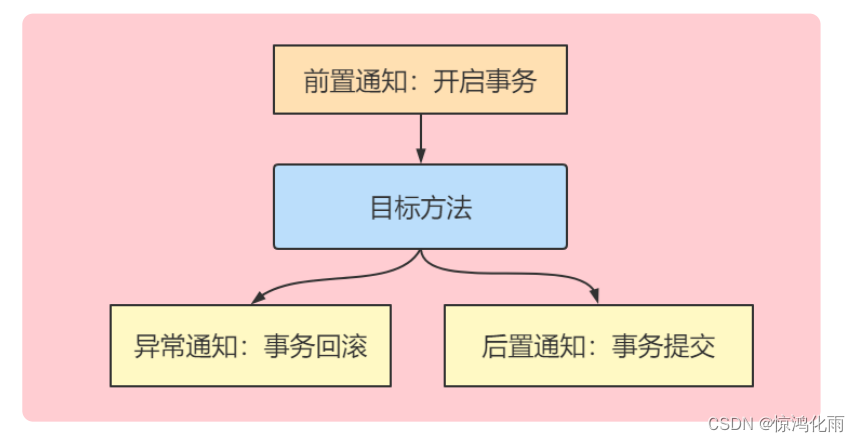
Spring事务_Spring事务管理器
Spring依赖事务管理器进行事务管理,事务管理器即一个通知类,我们为该通知类设置切点为service层方法即可完成事务自动管理。
由于不同技术操作数据库,进行事务操作的方法不同。如:JDBC提交事务是 connection.commit() ,MyBatis提交事务是 sqlSession.commit() ,所以Spring提供了多个事务管理器。
| 事务管理器名称 | 作用 |
|---|---|
| org.springframework.jdbc.datasource.DataSourceTransactionManager | 针对JDBC技术提供的事务管理器。适用于JDBC和MyBatis。 |
| org.springframework.orm.hibernate3.HibernateTransactionManager | 针对于Hibernate框架提供的事务管理器。适用于Hibernate框架。 |
| org.springframework.orm.jpa.JpaTransactionManager | 针对于JPA技术提供的事务管理器。适用于JPA技术。 |
| org.springframework.transaction.jta.JtaTransactionManager | 跨越了多个事务管理源。适用在两个或者是多个不同的数据源中实现事务控制。 |
我们使用MyBatis操作数据库,接下来使用 DataSourceTransactionManager 进行事务管理。
- 引入依赖
<!-- 事务管理 -->
<dependency>
<groupId>org.springframework</groupId>
<artifactId>spring-tx</artifactId>
<version>5.3.13</version>
</dependency>
<!-- AspectJ -->
<dependency>
<groupId>org.aspectj</groupId>
<artifactId>aspectjweaver</artifactId>
<version>1.8.7</version>
</dependency>
- 引入约束
xmlns:aop="http://www.springframework.org/schema/aop"
xmlns:tx="http://www.springframework.org/schema/tx"
http://www.springframework.org/schema/aop
http://www.springframework.org/schema/aop/spring-aop.xsd
http://www.springframework.org/schema/tx
http://www.springframework.org/schema/tx/spring-tx.xsd
- 进行事务配置
<!-- 进行事务配置 -->
<tx:advice id="txAdvice">
<tx:attributes>
<!-- propagation:设置事务的传播方式 isolation:设置方法的事务隔离级别 -->
<tx:method name="*" propagation="REQUIRED" isolation="DEFAULT"/>
<!--设置查询方法为只读事务-->
<tx:method name="find*" read-only="true" isolation="READ_UNCOMMITTED"></tx:method>
</tx:attributes>
</tx:advice>
<!-- 配置切面 -->
<aop:config>
<aop:pointcut id="myPoint" expression="execution(* com.gb.service.*.*(..))"/>
<aop:advisor advice-ref="txAdvice" pointcut-ref="myPoint"></aop:advisor>
</aop:config>
Spring事务_事务控制的API
Spring进行事务控制的功能是由三个接口提供的,这三个接口是Spring实现的,在开发中我们很少使用到,只需要了解他们的作用即可:
PlatformTransactionManager接口
PlatformTransactionManager是Spring提供的事务管理器接口,所有事务管理器都实现了该接口。该接口中提供了三个事务操作方法:
- TransactionStatus getTransaction(TransactionDefinition definition):获取事务状态信息。
- void commit(TransactionStatus status):事务提交
- void rollback(TransactionStatus status):事务回滚
TransactionDefinition接口
TransactionDefinition是事务的定义信息对象,它有如下方法:
- String getName():获取事务对象名称。
- int getIsolationLevel():获取事务的隔离级别。
- int getPropagationBehavior():获取事务的传播行为。
- int getTimeout():获取事务的超时时间。
- boolean isReadOnly():获取事务是否只读。
TransactionStatus接口
TransactionStatus是事务的状态接口,它描述了某一时间点上事务的状态信息。它有如下方法:
- void flush() 刷新事务
- boolean hasSavepoint() 获取是否存在保存点
- boolean isCompleted() 获取事务是否完成
- boolean isNewTransaction() 获取是否是新事务
- boolean isRollbackOnly() 获取是否回滚
- void setRollbackOnly() 设置事务回滚
Spring事务_事务的相关配置
在<tx:advice>中可以进行事务的相关配置:
<tx:advice id="txAdvice">
<tx:attributes>
<tx:method name="*"/>
<tx:method name="find*" read-only="true"/>
</tx:attributes>
</tx:advice>
<tx:method>中的属性:
- name:指定配置的方法。 * 表示所有方法, find* 表示所有以find开头的方法。
- read-only:是否是只读事务,只读事务不存在数据的修改,数据库将会为只读事务提供一些优化手段,会对性能有一定提升,建议在查询中开启只读事务。
- timeout:指定超时时间,在限定的时间内不能完成所有操作就会抛异常。默认永不超时
- rollback-for:指定某个异常事务回滚,其他异常不回滚。默认所有异常回滚。
- no-rollback-for:指定某个异常不回滚,其他异常回滚。默认所有异常回滚。
- propagation:事务的传播行为
- isolation:事务的隔离级别
Spring事务_事务的传播行为
事务传播行为是指多个含有事务的方法相互调用时,事务如何在这些方法间传播。
如果在service层的方法中调用了其他的service方法,假设每次执行service方法都要开启事务,此时就无法保证外层方法和内层方法处于同一个事务当中。
// method1的所有方法在同一个事务中
public void method1(){
// 此时会开启一个新事务,这就无法保证method1()中所有的代码是在同一个事务中
method2();
System.out.println("method1");
}
public void method2(){
System.out.println("method2");
}
事务的传播特性就是解决这个问题的,Spring帮助我们将外层方法和内层方法放入同一事务中。
| 传播行为 | 介绍 |
|---|---|
| REQUIRED | 默认。支持当前事务,如果当前没有事务,就新建一个事务。这是最常见的选择。 |
| SUPPORTS | 支持当前事务,如果当前没有事务,就以非事务方式执行。 |
| MANDATORY | 支持当前事务,如果当前没有事务,就抛出异常。 |
| REQUIRES_NEW | 新建事务,如果当前存在事务,把当前事务挂起。 |
| NOT_SUPPORTED | 以非事务方式执行操作,如果当前存在事务,就把当前事务挂起。 |
| NEVER | 以非事务方式执行,如果当前存在事务,则抛出异常。 |
| NESTED | 必须在事务状态下执行,如果没有事务则新建事务,如果当前有事务则创建一个嵌套事务 |
Spring事务_事务的隔离级别
事务隔离级别反映事务提交并发访问时的处理态度,隔离级别越高,数据出问题的可能性越低,但效率也会越低。
| 隔离级别 | 脏读 | 不可重复读 | 幻读 |
|---|---|---|---|
| READ_UNCOMMITED | (读取未提交内容) | Yes | Yes |
| READ_COMMITED | (读取提交内容) | No | Yes |
| REPEATABLE_READ | (重复读) | No | No |
| SERIALIZABLE | (可串行化) | No | No |
如果设置为DEFAULT会使用数据库的隔离级别。
- SqlServer , Oracle默认的事务隔离级别是READ_COMMITED
- Mysql的默认隔离级别是REPEATABLE_READ
Spring事务_注解配置声明式事务
- 注册事务注解驱动
<!-- 注册事务注解驱动 -->
<tx:annotation-driven transactionmanager="transactionManager"></tx:annotation-driven>
- 在需要事务支持的方法或类上加
@Transactional - 3 配置类代替xml中的注解事务支持:在配置类上方写
@EnableTranscationManagement


